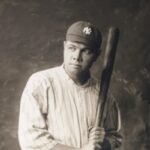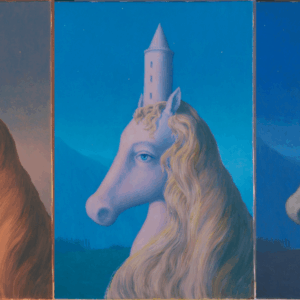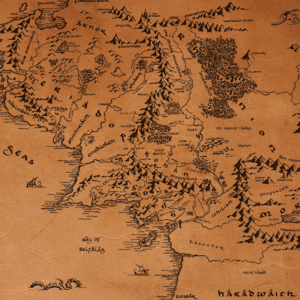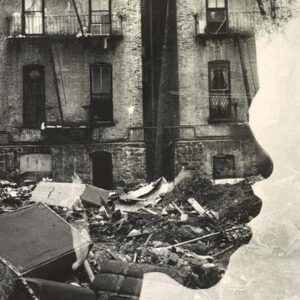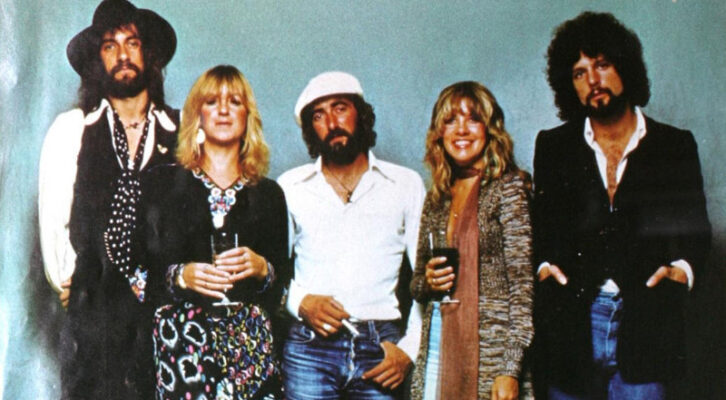
How Fleetwood Mac Helped Inspire Daisy Jones & the Six
Alan Light on the Literary Afterlife of Stevie Nicks and Lindsay Buckingham’s On- and Off-Stage Relationship
Stevie Nicks came up with the title of the song she has referred to as “the ballad of Stevie and Lindsey” when she saw an exit sign for Silver Spring (singular), Maryland, while Buckingham Nicks was on the road. “It sounded like a pretty fabulous place to me,” she said in the Classic Albums documentary. “It’s a whole symbolic thing of what [Lindsey] could have been to me.”
Caillat wrote that the production on “Silver Springs” was his favorite out of all the material for the album. Even as the band fought over trimming down the song, its momentum and laser focus only grew. “It doesn’t move the way a pop song is supposed to,” wrote Pitchfork. “Its verses simmer for nearly two-and-a-half minutes before erupting into the majestic chorus. When its haunting refrain beams down, it’s an act of emotional and artistic justice.” Nicks herself was so confident about the song that she assigned the publishing rights to her mother, assuming it would generate a healthy and steady income for her.
After 1977, though, “Silver Springs” was largely lost to the world. The band had actually added it into the set for the final run of the “white album” tour in 1976, while they were working on Rumours, and then dropped it. It went back in for one month of the actual Rumours tour—for the April 1977 dates in Europe—but then was removed from their live show for good.
Cut to 1995. Following the rush of good feelings around the reunion for the Clinton inauguration, Fleetwood Mac was back at a low point. The Time album, with a lineup that didn’t include Nicks or Buckingham, failed to chart in the US. Christine McVie told what remained of the band that the album would be her last.
Two decades later, it’s the culmination of all the subtext on Rumours, the last word from the woman who survived heartbreak and sacrifice and drug addiction and became an icon.
But then Buckingham and Fleetwood collaborated on a project; John McVie came along, and eventually Christine did, too, but it ultimately fizzled out. The real breakthrough came when Nicks asked Buckingham to produce a song for her for the Twister soundtrack, with Fleetwood playing the drums. In May 1996, Fleetwood, the McVies, and Nicks appeared together at a Kentucky Derby party. The parts were gradually lining up for a potential return to the five-piece Rumours-era roster.
On May 23, 1997, the world got what it wanted when the quintet gathered at Warner Bros. Studios in Burbank, California, for a one-night-only concert that would be released as The Dance. Buckingham originally wanted to minimize the set’s overlap with the 1980 Live album, but the label execs insisted that they focus on the greatest hits. Lindsey won enough of the argument, though, that the show included new material from all three of the primary songwriters and several deeper album cuts—which is presumably how the obscure “Silver Springs” found its way into the performance.
The Dance aired nonstop on MTV and VH1, and the album debuted at number one on Billboard’s album charts and became the fifth-best-selling live album of all time in the US. It spun off three singles, received three Grammy nominations, and led to a forty-four-date reunion tour that grossed $36 million.
But there was one moment, even as it was unfolding, that is what everyone remembers from The Dance. Midway through “Silver Springs,” Nicks fixes her glare on Buckingham and holds it for the rest of the song. She burns a hole straight through him as she sings, “I’ll follow you down ’til the sound of my voice will haunt you.”
This is it—two decades later, it’s the culmination of all the subtext on Rumours, the last word from the woman who survived heartbreak and sacrifice and drug addiction and became an icon and still proudly carries her sense of rage and hurt and survival.
“[It was] for posterity,” she later said about the dramatic onstage confrontation. “I wanted people to stand back and really watch and understand what [the relationship with Lindsey] was.”
Fred Schruers, who attended the taping for a Rolling Stone story, wrote that “Nicks was clearly going for the whole enchilada this time”; when he asked her about the “Silver Springs” moment, she said, “I never did that before,” adding that “when we’re up there singing songs to each other, we probably say more to each other than we ever would in real life.”
Buckingham was circumspect talking to Schruers about the performance. “‘Silver Springs’ always ends up in that place for me,” he said, “because she’s always very committed to what those words are about, and I remember what they were about then. Now it’s all irony, but there is no way you can’t get drawn into the end of that song.”
*
When The Dance came out in 1997, Taylor Jenkins Reid was a thirteen-year-old in Acton, Massachusetts, obsessed with the music video channels. She had never heard of Fleetwood Mac, but since the special was constantly airing (“inescapable,” she says), one day she ended up watching.
What she noticed was Stevie Nicks singing “Landslide” and the way that she and Buckingham looked at each other. Her first thought was “Who were these people?” Her next thought was “Oh, they’re in love with each other.”
“Imagine my surprise,” Reid would write years later in an essay for Reese Witherspoon’s book club, “when my mother later explained that, though they had once dated, they weren’t together anymore. This completely defied logic to me. But they love each other! I saw it with my own eyes!”
When she revisited The Dance, this time she noticed the “Silver Springs” performance. “Stevie sung like a woman scorned, holding that microphone like a weapon, drilling holes into Lindsey’s head with her eyes as she sang that her voice would haunt him. I was savvier then, I understood that sometimes looking like you’re in love or in hate are things you ramp up a bit to make a good show. I also understood then what I could never have conceived of in 1997: Love makes no goddamn sense.”
By 2017, Taylor Jenkins Reid was an established author, with five books under her belt, including the bestseller The Seven Husbands of Evelyn Hugo. She decided to write a rock and roll novel and found herself thinking about those feelings conjured up by The Dance. “I wanted to write a story about that,” she wrote, “about how the lines between real life and performance can get blurred, about how singing about old wounds might keep them fresh.
“For all of their tumult, Stevie and Lindsey probably still love each other and don’t love each other, hate each other and don’t hate each other,” Reid added. “There probably aren’t any words to describe it. It probably won’t ever be distilled perfectly in a song.”
She had read an oral history of the Laurel Canyon scene in Vanity Fair and thought that the format would be a good way to tell the story of a band. Daisy Jones & the Six chronicles the rise and fall of a group fronted by two charismatic lead singers—Daisy Jones and Billy Dunne—and their journey from obscurity to fame, complete with romantic tensions, personal crises, and drug problems. They make it to the cover of Rolling Stone but then, at their peak, after a sold-out show at Chicago’s Soldier Field, they call it quits.
The New York Times called Daisy Jones & the Six “stylish and propulsive if sometimes sentimental” and wrote that “it’s a way to love the rock ’n’ roll of the 1970s without apology, without cynicism, bell-bottoms and all.” After its publication in 2019, the book sold two million copies and quickly became a favorite with high school and college kids. And once again, it led them back to the band that served as Reid’s inspiration.
Of course, the actual plot of Daisy Jones & the Six bears only a passing resemblance to the Fleetwood Mac story. Even the fundamental conflict—LA free spirit Daisy is brought into an existing, struggling band; clashes with lead singer Billy; their inevitable attraction is complicated by his marriage; drama ensues—has very little to do with the Lindsey and Stevie saga.
But what Reid got very right (in addition to doing an impressively solid job on the period details and the craziness that comes with any band dynamic) was capturing that feeling she got from the “Landslide” and “Silver Springs” videos, the ways that personal and creative relationships get entangled, the commitment to the art that transcends all until it doesn’t.
Reese Witherspoon optioned the rights to Daisy Jones & the Six before it was even published and then made it a selection for her book club. It was acquired as a limited series by Amazon; production was delayed by the pandemic, which gave the actors who made up the band—fronted by Riley Keough, granddaughter of Elvis Presley, as Daisy—time to bond and feel more like a real group by the time the show aired in 2023.
Sam Claflin was cast in the role of Billy Dunne. He said that he grew up with Rumours as one of a handful of tapes in his parents’ car but that he didn’t really know who Fleetwood Mac was. “Then when I was in my twenties,” he told Deadline Hollywood, “I remember I was at drama school and my buddy was playing a Fleetwood Mac album, and I was like, ‘Who is this? How do I know all the words and all the songs, but I never know what the band’s called?’”
While Claflin was prepping for the Daisy Jones shoot, a friend sent him a video to watch. “He said, ‘I know the book. I’ve read the book, and the book always reminds me of this clip,’” the actor said. “He was the first person to send me that famous clip of them singing ‘Silver Springs’ where [Stevie Nicks] is just staring and shouting, like screaming at [Lindsey Buckingham]. And he’s looking at her longingly, trying to get through it. And I was like, ‘Oh my God, the chemistry, that connection, the history.’ And I remember being the one to show Riley that on almost like day one, saying ‘Have you seen this video? How Billy-Daisy is this?’”
What Reid got very right…was capturing that feeling she got from the “Landslide” and “Silver Springs” videos, the ways that personal and creative relationships get entangled.
The “Silver Springs” performance is loosely re-created in the Daisy Jones series with “Regret Me.” Suki Waterhouse, who plays keyboardist Karen Sirko, was already aware of the “Silver Springs” video and confirms that it was a critical element in the actors’ approach to their work.
“I watched that when I was eighteen or something,” she says. “I remember she turns towards Lindsey Buckingham and he looks sort of horrified. He looks at her and it’s kind of a confrontation. She’s red in the face and she gets stronger and stronger, and she’s just yelling, and it just feels so incredibly animalistic.”
Waterhouse says that on set, the group would regularly meet up and watch live footage of Fleetwood Mac like a football team watching game film. “Once a week, we would all gather and put a big screen up, and we would watch, in silence, a lot of videos of them performing,” she says. “There would always be a quietness. It felt like a really large responsibility to channel the essence of them into our work. That was a very big undertaking. So sitting and watching together was really important for us.”
When Daisy Jones & the Six premiered on Amazon Prime Video in March 2023, it debuted as the streamer’s number one series, with 1.5 billion social impressions within the first three days of the show’s rollout. The series received nine Emmy Award nominations, including Outstanding Limited or Anthology Series and Outstanding Lead Actress in a Limited or Anthology Series or Movie for Riley Keough.
Even the music composed for the show was successful. Overseen by Grammy-winning songwriter, producer, and multi-instrumentalist Blake Mills (Bob Dylan, Fiona Apple, John Legend), the Aurora album had cowriting credits from the likes of Marcus Mumford and Jackson Browne—way more legit than the project needed to be.
Variety said the Daisy Jones soundtrack had “classic rock sensibilities with an effortlessly modern feel,” and Rolling Stone wrote that the music was good enough to “imagine that the Six really were the biggest band in the world for a minute.” The album received a Grammy nomination for Best Compilation Soundtrack for Visual Media, and the songs amassed almost 300 million global streams. Daisy Jones & the Six themselves became the first fictional act from a movie or TV series to debut at number one on Billboard’s Emerging Artists chart or hit the summit of the iTunes Top Albums chart.
But no endorsement mattered more than the response the Daisy Jones series got from Stevie Nicks. “Just finished watching Daisy Jones + the 6 for the 2nd time,” she posted on social media on August 15, 2023. “In the beginning, it wasn’t really my story, but Riley seamlessly, soon became my story. It brought back memories that made me feel like a ghost watching my own story. It was very emotional for me. I just wish Christine could have seen it. She would have loved it. Hopefully it will continue…”
In a subsequent interview, Nicks explained her enthusiasm. “It was a very simple thing,” she told Devon Ivie of Vulture. “It was the kind of snappy sarcasm between Daisy and Billy, who in my mind was like me and Lindsey. It was the back-and-forth between the two of them. It was so good. It was so real and it was really so right on.” She noted that it wasn’t so much that the characters looked or dressed exactly like the real band, but an “essence,” a feeling in the way they interacted. “I would be watching and be like, Well, there you go. That’s exactly why we did it. That’s exactly why Fleetwood Mac stayed together for fifty years. It was all for the music. It was all just to keep the music going, and the show got it.”
__________________________________

From Don’t Stop: Why We (Still) Love Fleetwood Mac’s Rumours by Alan Light. Copyright © 2025. Available from Atria Books, an imprint of Simon & Schuster.
Alan Light
Emmy Award–winning music journalist Alan Light is the author of numerous books including The Holy or the Broken: Leonard Cohen, Jeff Buckley, and the Unlikely Ascent of “Hallelujah” (which was adapted into an acclaimed documentary), as well as Let’s Go Crazy: Prince and the Making of Purple Rain and biographies of Johnny Cash, Nina Simone, and the Beastie Boys. He was the cowriter of bestselling memoirs by Gregg Allman and Peter Frampton. Alan was a senior writer at Rolling Stone and the editor-in-chief of Vibe and Spin. He contributes frequently to The New York Times, Esquire, and The Wall Street Journal, among many publications, and cohosts the podcast Sound Up! With Mark Goodman and Alan Light.













